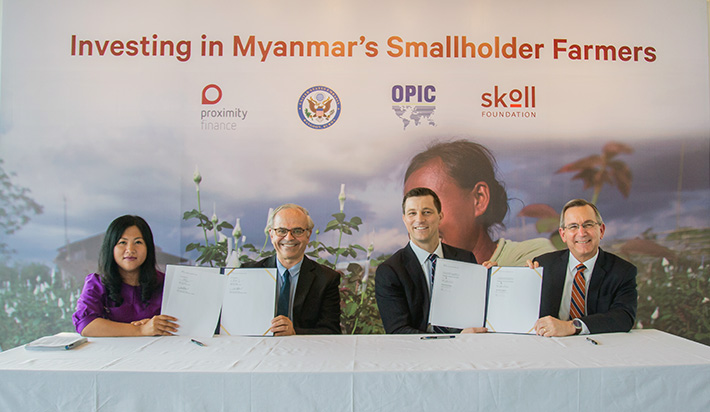We’re sometimes asked why we work in farming. Why, of all the many things we could task ourselves with, did we choose the incomes of smallholder farmers?
The answer is simple: If you want to help the people of Myanmar, farming is a pretty good place to start. Despite rapid urbanization in recent years, the population remains overwhelmingly rural. 70 percent of the population rely on the land for their livelihoods. This country of 55 million is a nation of smallholder farmers.
After decades of isolation, these farmers are left cut off from the kind of resources those working the land in other countries take for granted. Irrigation products that are standard elsewhere are hard to come by. Access to the kind of agronomy advice and training provided by governments elsewhere is scant. Perhaps most crippling of all, availability to the kind of affordable credit farmers need is vanishingly small.
The problem of financial inclusion is a broad one. It’s often said that Myanmar is a country that has two financial systems—one for the rich and one for everyone else. While a small minority participates in Myanmar’s nascent formal financial sector, the vast majority does not. Despite the inroads made by local financial institutions in recent years, more than two thirds of Myanmar’s people don’t have a bank account.
Yet the problem is most acutely felt in farming. The credit demands of running a small farm are intense. There’s a huge outlay of cash at planting time, to pay for seeds and hire labor to till the land. You then have to wait several months—hoping the weather, pests, and diseases are kind to your crops—before you can recoup your investment.
For most, the options for financing that investment are limited to say the least. Many are forced to rely on pawn shops, or informal moneylenders who can charge interest rates as high as 10 percent a month. These loans might serve the short-term credit need of the farmer but can often ensnare rural families in vicious cycles of debt.
For the past seven years we’ve made it our mission to help smallholder farmers in Myanmar navigate these unforgiving financial waters. As the first farmer-facing microfinance institution in the country we’re committed to deep knowledge and being proximate to the people we serve. Today, that stands at 100,000 household in 2,000 villages. But we’ve got big plans. By 2023 we’re aiming to serve 188,000 customers and to have dispersed 1 million loans. To scale so rapidly we need a lot of support.
That’s why were super excited to announce this week a major funding milestone in the signing of $10 million dollars in blended finance from our long-time partners at Skoll and the Overseas Private Investment Corporation (OPIC), the US government’s development finance institution.

OPIC has committed $8 million dollars, alongside $2 million of subordinated debt from Skoll. Pairing institutional debt with philanthropic capital in this way allows us to attract a growing portion of its investments at more commercial terms, de-risking the loan for the commercial parties and lowering the overall cost of the loan to Proximity. While the blended finance model has been around for years, it’s still quite a rare approach to create impact at scale in Myanmar.
“We see this blended finance model as a really innovative way to get the funding we need to be able to scale our impact,” said Ben Warren, our Head of Investment and Strategy.
“We’re looking to step up our impact over the next five years, from a portfolio of 100,000 to 188,000 smallholder farmers, and to do this we need to raise over $100 million of new funding. Normally we would rely on a number of smaller investments but this next phase of growth means that we need to find larger ticket sizes to scale up much quicker and this model allows us to do that.”
The signing of a commitment letter is the result of over a year’s work between Proximity Finance, OPIC, and Skoll to find an optimal structure. The agreed upon structure, with Skoll providing the ‘junior’ debt layer, and OPIC the ‘senior’ debt layer, illustrates the potential of the blended finance model to bring together investors with different risk and return appetites.
“This model enables Proximity Finance to leverage commercial capital from an organization like OPIC that we would not normally be able to access were it not for the presence of Skoll. Skoll plays a vital catalytic role in this model,” he said. “We have spent quite a bit of time working out the model with OPIC, so now we have a structure that we hope to be able to replicate with other investors in the future.”
“We’ve seen Proximity Finance’s impact and operational maturity grow since 2012 when we initially partnered with the organization,” said Liz Diebold, Principal at Skoll Foundation. “Access to the right kind of capital is the primary constraint to their ability to scale even further, which is why we are so supportive of this deal. We hope this $10 million package signals to other institutional lenders and concessional capital providers to contribute towards the $100 million target raise with bigger deal sizes and longer tenors”
At $10 million, this is our largest loan yet, and will go a long way towards expanding our operations and helping ensure credit access for more of Myanmar’s low-income farmers.
“It’s not just the size, but the length of time of this investment,” said Warren. “Most of our debt investments are an average of three years, but with a longer term we have the ability to recycle the money multiple times. This patient capital really boosts our ability for generating lasting impact.”